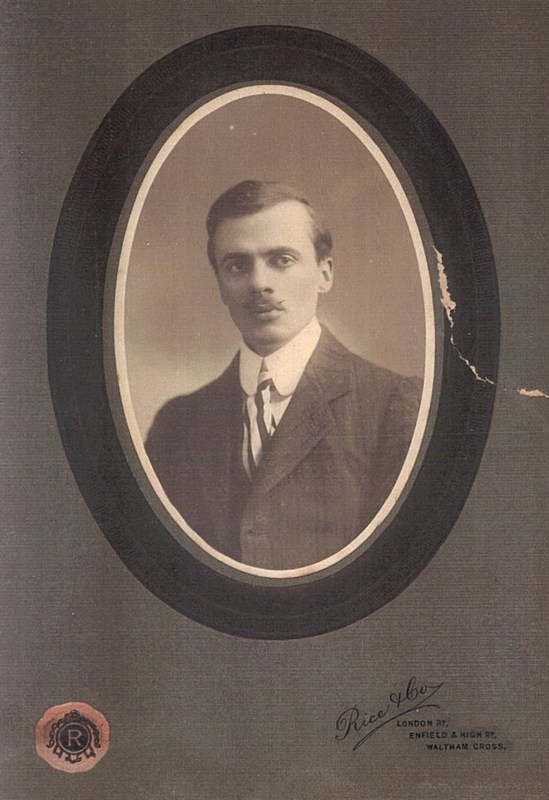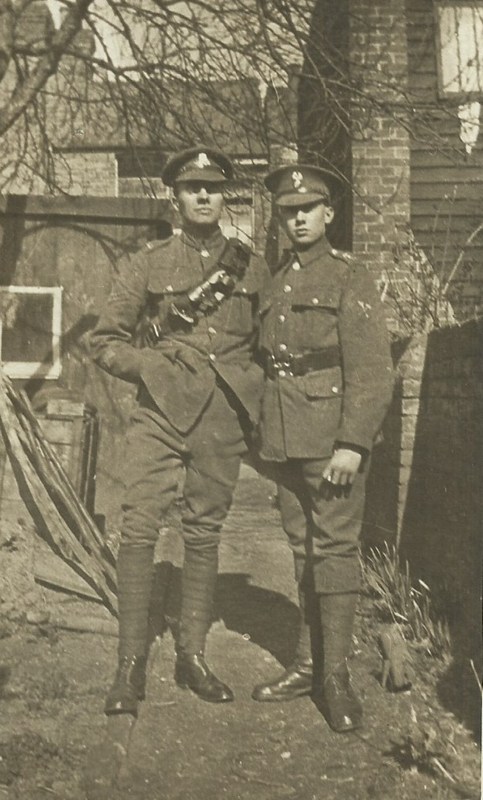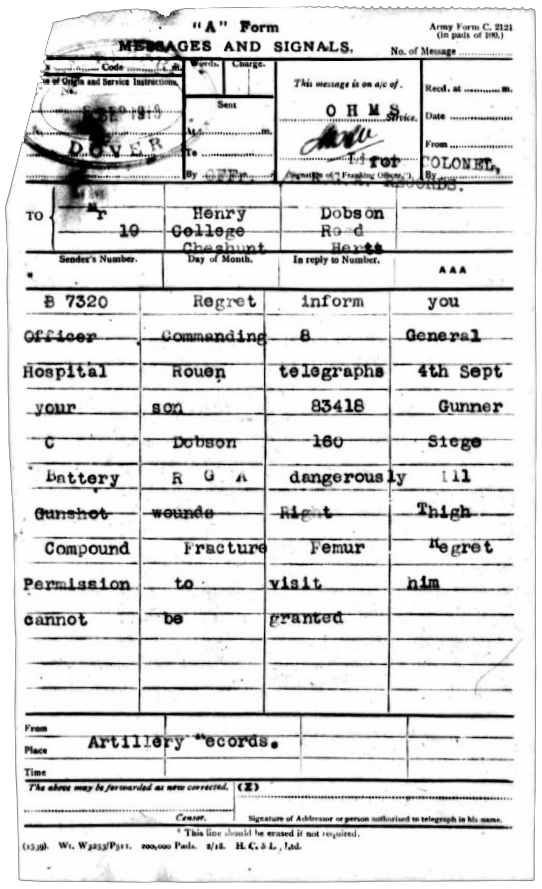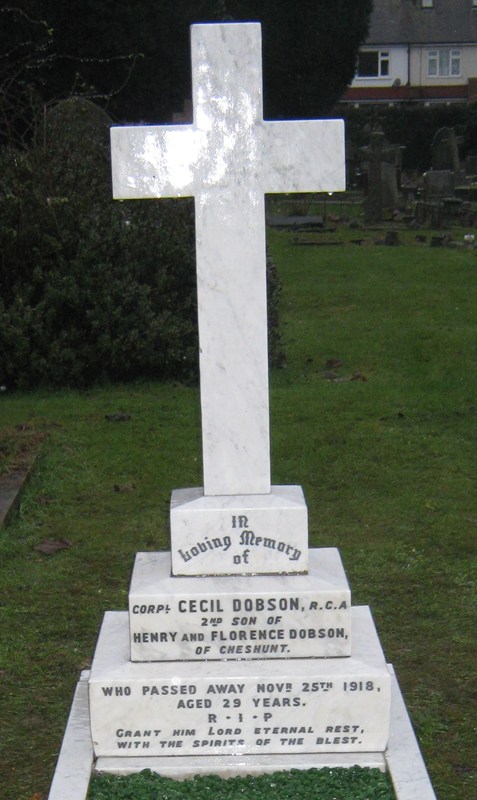Cecil Dobson
9th August 1889 – 25th November 1918
Corporal Cecil Dobson, Royal Garrison Artillery, 160th Siege Battery, Regimental Number 83418, was wounded in action in France on 2nd September, 1918, and died in Birmingham General Hospital on 25th November, 1918.
His Family
Cecil was one of eleven children born to John Henry Dobson (born 28th March 1859) and Sara Florence Lyons (born 29th January, 1861).
His father was known as Henry and came from Wilton, near Pickering in North Yorkshire. He joined the Police at the age of 24 at Hammersmith, London, and transferred to Chatham in the following year. Sarah was born in Stapleford, just south of Cambridge.1 They probably met in London as, in 1881, she was one of 14 servants at 40 Portman Square, the home of Sir Michael Edward Hicks Beach,2 1st Earl St Aldwyn, and his wife Lady Lucy Catherine Fortescue, daughter of Hugh Fortescue, 3rd Earl Fortescue. Sarah was Second Nurse and would have had responsibilities looking after the four Beach children, aged at this time between 5 and 1 years. The two-year-old, Susan, would later become the sitter representing Britannia on the reverse of the Edward VII silver florins.
Constable Dobson was on duty only 3 miles away from Sarah’s home and workplace. Despite Henry’s two years in the Medway district, the relationship survived and they were married in the grand surroundings of St. George’s, Hanover Square, on the 81th July, 1885. They settled in Waltham Abbey and in just over one year their first child was born. It was to become a large family:
Henry, b.1886, d.1973
William, b. 1888, d.1889
Cecil, b.1889, d.1918
Florence Emma, b. 1892
Jane Grace, b.1893, d.1983
Edith, b.1895, d.1978
Robert Victor, b.1897
Frank, b.1899, d.1979
Ellen Agnes, b.1901, d.1975
Alec James, b.1904, d.1975
Ivy Allanson, b.1905, d.1905
All the children were born in Waltham Abbey, then a small village surrounded by open countryside.3 The family home at 38 Greenfield Street must have been very crowded as it was a small two-bedroomed yellow brick terrace house—certainly a far cry from Portman Square.
Cecil, and presumably his brothers, attended Waltham Abbey Boys’ Council School, also known as the Board School4 in Milton Street. It was only two streets away from the family home.
Cecil, having shown great promise as a pupil, was retained after normal leaving age and given a small wage as a pupil-teacher. Thus, at the age of sixteen, he began his journey into the teaching profession. It may be that he was encouraged down this career path by his policeman-father who had been brought up in a schoolmaster’s household in North Yorkshire.5
At some point before the 1911 census, the family had moved 2 miles to 19 College Road, Cheshunt. Cecil was still living at home, along with father, mother and 7 siblings—Henry and William (25 and 23) having flown the nest. Cecil had become an assistant teacher, though he is listed as a school teacher’. His younger sister Jane is marked ‘School Student Scholarship’ but it is unclear whether this is a pupil-teacher scholarship or a general scholarship. Father Henry, now 2 years retired and on his police constable’s pension of £58 5s. 4d. per annum, is augmenting his income by working for the County Council as a School Attendance Officer.
Cecil was probably given his promotion to assistant teacher at the age of eighteen (September 1907) as new 1905 regulations restricted pupil teachers to a two-year appointment. His later college Student Record shows that his promotion kept him at the Board School. He would continue to teach at this school until the end of the 1910-1911 school year before taking the next step towards certificated teacher status: formal training. His college entrance exams (Preliminary Examination for the Certificate and Certificate Examination, passed in 1908 and 1910 respectively) show that he had an aptitude for science, in which he gained a Distinction. He had also gained a separate First Class pass in Elementary Chemistry.
To Winchester Training College, 1911-1913
Students would have a fairly rigorous timetable that regulated most of their day, and this included morning and evening Chapel services. The curriculum was broad. At the centre were the mainstays of what today we call numeracy and literacy, but lectures would encompass art, psychology, hygiene, literary criticism, history, music, science, psychology, education, and speech. Extended periods of practical teaching were also undertaken at one of the local Practising Schools.
Cecil’s first Wintonian poem, a composition with more than a faint echo of Longfellow:
The People of the Mist or The Water Babies
(On view every night at 10 p.m.)
Seeking peace, one night I wandered,
Wandered down a darkened passage,
Hearing nothing, save my footsteps
Echoing on the stony floor.
Then unto mine ears came floating
Music, mellowed by the distance,
Mystic music, soft and charming,
Banishing all carking care.
So I hastened to a cavern
Whence did come the blissful music,
To a cavern wreathed in vapour
Where the splashing of the waters
Mingled with enchanting singing,
Singing of sweet songs in ragtime,
Singing merry College ditties.
How I wished to enter there!
As I listened, time unheeding,
Stopped, the rushing of the waters
Stayed the sound of music pleasing
And weird sounds began arising
Like the sound of porpoise snorting,
Like the croaks of frogs a-croaking.
Then I heard some sweet voice asking,
Where’s the soap!
Whilst I wondered how to enter,
Came along the blythe curator,
Told me in his gentlest whisper
How I might these gay realms enter,
Realms of mystery and song.
These the words he told me, whispering,
Rise up early in the morning,
Early when the first bell’s ringing,
Dress with haste and dress with speed.
Write thy name here, write it clearly,
State thy name, – the day, – the time;
Then, Oh Unwashed, thou shalt revel
In these watery joys divine.
There are snapshots of the more recreation side of student life at College in the student publication The Wintonian. It is here we find that Cecil had a poetic streak. Two of his poems were reproduced in full.
As College days drew to a close, the friendships Cecil had forged there would not fade. In 1874 an association of old students—the Winton Club—had been formed, providing reunion meetings to keep those ties and to remember shared times. To give a taste of the Club, it is worth repeating the report of the inaugural meeting in full:6
lt has long been the wish of the national schoolmasters and others who have been trained at this College to form a society or club, in order that they might meet together occasionally, and thus, by mutual intercourse, preserve old friendships and show a more real appreciation of their place of education. This year a committee of old students (schoolmasters) was formed, and a successful attempt to set on foot such a society has been the result. A large party of schoolmasters, formerly trained at the Winchester Training College, met on Friday at the College, and afterwards sat down to an excellent cold collation provided by Mr. Grant, of the Old Market Hotel. The Principal (the Rev. C. Collier, M.A.) was chairman, and the Vice-Principal (Mr. C. G. Brown), vice-chairman. About forty were present. The loyal toasts of The Queen, Prince and Princess of Wales, and the rest of the Royal Family, were duly honoured, and Archdeacon Jacob responded to that of The Bishop and Clergy of the Diocese; and Mr. Hunt and Mr. Smith for The Army, Navy, and Volunteers. The Board of the W. D. Training College was proposed by Mr. Atkins, of the Central Schools, Winchester, and was responded to by the Rev. W. Midwinter. The health of the former principal (the Rev. J. Smith) was proposed by Archdeacon Jacob, and responded to by Mr. Smith. That of The present Principal, by Mr. Bush, of Botley School, and duly and effectively spoken to by the rev. chairman. The Masters (past and present). proposed by Mr. Brummell, of Woking was responded to by Mr. Carter and Mr. Brown. Success to the Winchester Training College was proposed by Mr. Sandford, of Alverstoke, and Success to the Winton Club by Mr. Orchard, of the Training College, the latter being responded to by Mr. Maidment, were the last on the list, the whole having been interspersed with glees7 sung by the students, concluding with Auld lang syne. The members of the committee and their indefatigable secretary may be congratulated on their success. The club has now a fair start, and it is hoped that next year, when the addresses of the old students become better known to the committee, there will be a still larger meeting; and necessitate a resort to the New Guildhall for the gathering.
Small, geographical expressions of Winton Club were formed for convenience and we find that ‘On Friday March 13th,8 the 11-13 men resident in and around London held their first reunion.Those present were Burt, Dobson, Eason, Hotten, Moore A. R., Wootton, and Wilson.’
Old students valued their time at the College and often looked back on days there with fondness and wistfulness. The Wintonian carries the thoughts of one student which illustrate this sentiment:
‘Thus we are about to leave this dear old place. The two years that have passed will never be forgotten, and our doing here will soon be existing only in remembrance.’
College records show that on leaving at the end of his course, Dobson took up a teaching post at County School, Chingford, Essex, commencing in September 1913 and where he would teach until the War.
Into Action
Cecil’s Army Records survive. This gives us a good insight into his life in khaki.
He enlisted twice. First of all, on 20th March, 1915, he joined the Territorial 3/5th Battalion London Royal Army Medical Corps (Regimental Number 2158); then, at Cooden Camp, Bexhill, he enlisted into the regular army as Gunner with the Royal Garrison Artillery (Regimental Number 83418) on 15th May, 1916. This was quite in order and, as ever, there was an Army form to meet the occasion which made his first enlistment non-effective. His medical report shows that he was 5 feet 8½ inches in height, weighed 8st. 10lbs., had a 35½ inch chest, perfect vision, good physical development but a slightly dilated heart.
It was at Cooden Camp that Cecil was trained in ‘Plotting and Observation of Fire’ and was passed as ‘Very Good’ on 30th June, 1916. This was to become his role in the conflict.
He was part of 160th Siege Battery of the Royal Garrison Artillery. Siege Batteries were equipped with the biggest guns in the Army, heavy howitzers of 6, 8, 9.2 and even some 12-inch calibre, sending high explosive shells in high trajectory fire. As tactics developed, the Siege Batteries were most often employed in destroying enemy artillery, strongpoints, dumps, stores, roads and railways, behind enemy lines.
The scale of the operation was enormous. Gunner Frank Carter, a teacher in civilian life and a fellow-member of Cecil’s 160th Siege Battery, wrote home,
I calculate that since we came out in September 1916 our battery alone has fired at least a hundred thousand rounds of shell. That means that we have used nearly five thousand tons of steel. One battery, remember, out of thousands that are out here.9
The Records give us a skeleton of main events in Cecil’s war, but not details of engagements:
Home 15th May to 17th September, 1916
Promoted to Bombadier 10 29th August 1916
Embarked at Southampton 18th September 1916
Landed at Le Harvre 19th September 1916
Acting Corporal 21st August, 1917 to 31st December, 1917.
Leave to England September 1917 (5 days) and March 1918 (9 days)
April 1918: 18 days seconded to the RAF
Acting Corporal 24th April to 14th June, 2018
Promotion to Corporal 11th July 1918
The secondment to the RAF is of particular interest. In early September, during the Second Battle of Somme, Cecil’s Battery was shelling the Péronne (Somme) area: About 1600 rounds on Harassing and Bombardment and 420 on C.B. [Creeping Barrage] work. PERONNE and neighbouring targets again engaged from 5.30am to 7.10am in support of Infantry operations. Many have recently been engaged at request of 15th Australian Infantry Brigade whose front we cover and with which we have a Liason [sic] officer. The diary notes that they were using observers in tethered balloons and it would appear that Cecil had received training in balloon observation.
On Monday the 2nd of September 1918 Cecil was severely wounded. He received a gunshot wound in the right thigh which had severed the femur, causing a compound fracture. He is not mentioned in the day’s diary by name, only that 160th Siege Battery had 4 Other Ranks killed and 3 wounded.
He was immediately evacuated to Rouen Hospital, arriving there the following day. His family were immediately informed that he was dangerously ill but that permission to visit was denied (see copy of telegram, below). On September 6th he was returned to England on the hospital ship SS Panama and immediately transferred to Birmingham General Hospital. His stay there was to last just over 11 weeks. Two weeks after the Armistice, on Monday, 25th November, 1918 Cecil died. The cause of death was stated as ‘Compound fracture femur and thigh received in Action and pneumonia’.
Cecil was brought home and his body laid to rest in Cheshunt Cemetery. He was survived by his mother and father.
Researcher and Author: John Vickers
Footnotes
- Her place of birth varies in records between this, Great Shelford, Shelford and Gogmagog, the name of the small hills in this area. The etymology of the latter is uncertain; it may be from the Biblical Gog and Magog or Gogmagog, a legendary British giant.
- He was an MP from 1864 and held a succession of Cabinet positions, becoming Chancellor of the Exchequer and Leader of the House of Commons
- In 1902 the entire 17 square-miles parish of Waltham Holy Cross, including outlying villages, was only 6,066.
- Board School, Milton Street. Boys’ school erected in 1882, for 310 children; average attendance, 269; Arthur J. Jones, master; Girls’ school erected in 1874, for 350; average attendance, 255; Miss Marian Walker, mistress; Infants’ school erected in 1878, for 400 children; average attendance, 270; Miss Kate Rosewell, mistress. Source: Kelly’s Directory of Essex, 1902
- Henry’s father was Robert Dobson. Born 1826 in Newton, Yorkshire, he was schoolmaster in Wilton, North Yorkshire. He died in 1880 in nearby Sinnington. In such a small rural village it is likely that Henry would have been taught by his father.
- Hampshire Advertiser, Wednesday 2nd September, 1874
- Part-songs for men’s voices
- 1914. Source: The Wintonian 1910-1914 collection
- Bully Beef and Biscuits: Food in the Great War by John Hartley. The calculations show that the Battery were probably using mainly 6-inch howitzers (100lb. shells).
- Ranks, from low to high, were Gunner, Bombardier, Corporal
Sources
Ancestry (2018). Home page. [online] Available at: www.ancestry.co.uk [Accessed 2018]
British Newspaper Archive (2018). Hampshire Advertiser, Wednesday 2nd September, 1874. [online] Available at: www.britishnewspaperarchive.co.uk [Accessed 2018]
Commonwealth War Graves Commission, (2018). Home page. [online] Available at www.cwgc.org/ [Accessed 2018]
Hartley, J. (2015). Bully Beef and Biscuits: Food in the Great War. Barnsley: Pen and Sword Books
Newbattle at War (2018). 160th Siege Battery Royal Garrison Artillery. [online] Available at http://www.newbattleatwar.com/apps/photos/photo?photoid=3066579 [Accessed 2018]
Rose, M. (1981). A history of King Alfred’s College, Winchester 1840-1980. London: Phillimore
Temke, Anna. Photographs, courtesy of (Ancestry, see above)
Vickers, J. The University of Winchester Chapel Memorial Rail image
| University of Winchester Archive “ Hampshire Record Office | ||
| Reference code | Record | |
| 47M91W/ | P2/4 | The Wintonian 1899-1900 |
| 47M91W/ | P2/5 | The Wintonian 1901-1902 |
| 47M91W/ | P2/6 | The Wintonian 1903-1904 |
| 47M91W/ | P2/7 | The Wintonian 1904-1906 |
| 47M91W/ | P2/8 | The Wintonian 1905-1907 |
| 47M91W/ | P2/10 | The Wintonian 1908-1910 |
| 47M91W/ | P2/11 | The Wintonian 1910-1914 |
| 47M91W/ | P2/12 | The Wintonian 1920-1925 |
| 47M91W/ | D1/2 | The Student Register |
| 47M91W/ | S5//5/10 | Photograph of 5 alumni in Mesopotamia |
| 47M91W/ | Q3/6 | A Khaki Diary |
| 47M91W/ | B1/2 | Reports of Training College 1913-1914 |
| 47M91W/ | Q1/5 | Report and Balance Sheets 1904- 1949 |
| 47M91W/ | R2/5 | History of the Volunteers Company 1910 |
| 47M91W/ | L1/2 | College Rules 1920 |
| Hampshire Record Office archive | ||
| 71M88W/6 | List of Prisoners at Kut | |
| 55M81W/PJ1 | Managers’ Minute Book 1876-1903 | |
| All material referenced as 47M91W/ is the copyright of The University of Winchester. Permission to reproduce photographs and other material for this narrative has been agreed by the University and Hampshire Record Office. | ||








